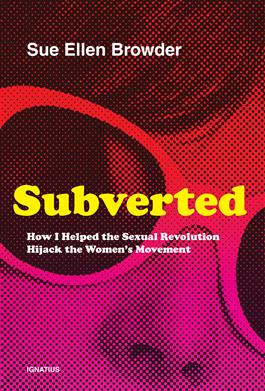
By Bonnie Finnerty, Education Director
It might seem implausible that a small number of people would wield such power, but truth, after all, is stranger than fiction.
And the truth about what happened at New York City’s Mayflower Hotel on November 18, 1967 is not well known. So the story must be told.
In her expose Subverted: How I Helped the Sexual Revolution Hijack the Women’s Movement, Sue Ellen Browder uses transcribed minutes of the National Organization for Women’s Second Convention to reveal the tug of war between factions, the rising hostilities over abortion, and the final vote that would drive one-third of the attendees to part ways with NOW.
Browder allows us to be “A Fly on the Wall of the Chinese Room,” witnessing the sabotage of a once-noble movement as the group carves out their own Bill of Rights. Eighty-nine people registered for the convention, including a handful of men, but 105 attend, the result of students and radicals showing up.
Two leaders sit side-by-side at the head table. One is 46 year-old author Betty Friedan, a flamboyant, combative atheist and mother to three children whose volatile marriage is headed for divorce. Only recently had she accepted abortion as an issue essential to women’s rights, thanks to the influence of friend Larry Lader.
Seated beside her as the parliamentarian charged with keeping peace is much older Marguerite Rawalt, a dignified, retired attorney. Known as a bridge builder and D.C. insider, her nationwide connections with professional women include long-time friend Alice Paul, leader of the suffragette movement. Widowed after 26 years of a happy marriage, Marguerite’s deep Presbyterian faith guides her world view.
While their style and life experience differ greatly, much unites Betty and Marguerite in their work for women’s rights: equal pay for equal work, increasing roles in the political arena, and expanding educational opportunities.
But the abortion issue, saved for the final resolution of the convention, divides them. To the shock of many, Betty presses for full repeal of all abortion laws, sparking fiery debate among NOW members. Further, she fails to show equal treatment to opposing sides, frequently shutting people down. Dr. Shepherd Aaronson, the only doctor in the room, was “shut up in no uncertain terms” while women who knew nothing of abortion were allowed to speak.
Many press for a delay in making a statement on abortion until further study, but a small group of radicals grows increasingly vocal. When a revised statement about abortion is offered, Friedan scoffs. “We should not compromise,” she declares. “We must pioneer.”
A furious Marguerite Rawalt fears that abortion will take over NOW’s agenda and replace the “genuine legal battles for equality.” She is far from alone.
When a vote is taken, a “Mere 57” members call for the total repeal of all abortion laws as part of NOW’s platform. In that moment “the women’s movement and the sexual revolution became united as one in the eyes of the media and the world. The unholy marriage was consummated.”
While Friedan was able to secure a majority, Browder reports a discrepancy between the number of people voting and the number of people in attendance, a mystery that to this day remains.
Many members felt that Betty “rammed through the vote for abortion in a totally undemocratic process.” Television broadcaster and NOW official Paige Palmer accused Friedan of “overbearing behavior during the abortion debate” and “railroading.” Attorney Elizabeth Boyer quit NOW’s board of directors, later founding the Women’s Equality Action League (WEAL), an organization focused on ending sex discrimination and staying out of the abortion debate.
Overtime, Friedan expressed regrets at this division in the women’s movement. In the 1980’s she observed that “women of childbearing years were dividing into bitter antagonistic camps as they were forced into no-win, either-or choices, motherhood vs. career.”
In her book The Second Stage, she called for the women’s movement to stop overemphasizing abortion rights and reaffirm the importance of the family, noting that “The women’s movement…has come to a dead end…Our failure was our blind spot about the family.”
But as Browder states, “The dirty deed was done and there was no turning back…Working mothers and single women of child-bearing age had been betrayed.”
All because of a Mere 57.
(Please join us in reading Chapters 7 and 8 for next week.)
Quotable quotes
“Whenever human rights are divided, hate and violence erupt, as one person’s rights are pitted against another’s.” (p. 65)
“NOW’s abortion plank gave the U.S. government, universities, and all of corporate America (including major media monopolies) a convenient, expedient way to escape from having to provide day care, parental leave, and other benefits for mothers and families.” (p. 73)

